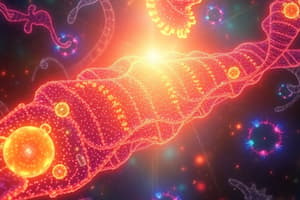Podcast
Questions and Answers
What term is used to describe the process by which abnormal masses of tissue grow, proliferate, and persist beyond the normal growth patterns of the surrounding tissue?
What term is used to describe the process by which abnormal masses of tissue grow, proliferate, and persist beyond the normal growth patterns of the surrounding tissue?
- Hyperplasia
- Dysplasia
- Metaplasia
- Neoplasia (correct)
Which type of neoplasm is characterized by invasion and metastasis?
Which type of neoplasm is characterized by invasion and metastasis?
- Adenoma
- Carcinoma (correct)
- Fibroadenoma
- Sarcoma
What is the distinguishing feature of benign neoplasms?
What is the distinguishing feature of benign neoplasms?
- Uncontrolled growth
- Invasion and metastasis
- Absence of invasion and metastasis (correct)
- Medical emergency
Which term is commonly used to refer to benign tumors of glandular cells?
Which term is commonly used to refer to benign tumors of glandular cells?
What type of neoplasm can spread to distant organs and tissues?
What type of neoplasm can spread to distant organs and tissues?
In neoplasm nomenclature, what type of neoplasm name typically ends in '-sarcoma'?
In neoplasm nomenclature, what type of neoplasm name typically ends in '-sarcoma'?
What is cancer cachexia characterized by?
What is cancer cachexia characterized by?
Which condition can cancer-associated pain be caused by?
Which condition can cancer-associated pain be caused by?
What are paraneoplastic syndromes caused by?
What are paraneoplastic syndromes caused by?
Which of the following is a characteristic of cancer cachexia?
Which of the following is a characteristic of cancer cachexia?
What is crucial for improving patients' quality of life in cancer care?
What is crucial for improving patients' quality of life in cancer care?
In which area of research is understanding cancer cachexia important?
In which area of research is understanding cancer cachexia important?
Flashcards are hidden until you start studying
Study Notes
Neoplasia: Definition, Nomenclature, and Clinical Aspects
Neoplasia is the process by which abnormal masses of tissue grow, proliferate, and persist beyond the normal growth patterns of the surrounding tissue. These abnormal masses are known as neoplasms. The term "neoplasia" refers to the uncontrolled growth of cells, which can lead to benign or malignant neoplasms depending on the type and behavior of the cells involved.
Benign Neoplasms
Benign neoplasms are characterized by the absence of invasion or metastasis, and they do not pose a significant threat to the patient's health. They are often removed for cosmetic reasons or to alleviate symptoms caused by the tumor's size or location. Examples of benign neoplasms include adenomas (benign tumors of glandular cells) and fibroadenomas (benign tumors of connective tissue).
Malignant Neoplasms
Malignant neoplasms, also known as cancers, are characterized by the presence of invasion and metastasis. They can spread to distant organs and tissues, causing damage and potentially life-threatening complications. Examples of malignant neoplasms include carcinomas (malignant tumors of epithelial cells) and sarcomas (malignant tumors of connective tissue).
Nomenclature
Neoplasms are classified based on their tissue of origin, with names ending in "-oma" for benign neoplasms and "-carcinoma" or "-sarcoma" for malignant neoplasms. Some exceptions to this rule include hepatoma (malignant tumor of the liver), melanoma (malignant tumor of melanocytes), mesothelioma (malignant tumor of mesothelial cells), and seminoma (malignant germ cell tumor of the testis).
Clinical Aspects
Understanding the clinical aspects of neoplasia is crucial for the accurate diagnosis and treatment of cancer. Some key concepts related to neoplasia include cancer-associated pain, cancer cachexia (a wasting syndrome associated with cancer), and paraneoplastic syndromes (conditions that occur secondary to the presence of a malignant neoplasm).
Cancer-associated pain
Cancer-associated pain is a common symptom experienced by many patients with malignant neoplasms. It can be caused by the tumor itself or by the treatments used to treat the cancer. Effective pain management is essential for improving patients' quality of life and ensuring they can receive appropriate cancer care.
Cancer cachexia
Cancer cachexia is a complex metabolic disorder characterized by loss of skeletal muscle mass, anorexia, and metabolic abnormalities. It is associated with poor prognosis, reduced responsiveness to treatments, and increased mortality. Understanding the mechanisms of cancer cachexia and developing effective interventions is an active area of research in the field of oncology.
Paraneoplastic syndromes
Paraneoplastic syndromes are conditions that occur secondary to the presence of a malignant neoplasm. These syndromes can be caused by autoimmune responses, abnormal production of hormones, or other mechanisms. They can manifest as a wide range of symptoms, including neurological, endocrine, and hematological abnormalities. Early recognition and appropriate management of paraneoplastic syndromes are essential for improving patients' outcomes.
In conclusion, neoplasia is a critical aspect of cancer biology, encompassing the uncontrolled growth of cells leading to the formation of benign or malignant neoplasms. Understanding the clinical aspects of neoplasia, including cancer-associated pain, cancer cachexia, and paraneoplastic syndromes, is essential for the accurate diagnosis and treatment of cancer patients.
Studying That Suits You
Use AI to generate personalized quizzes and flashcards to suit your learning preferences.




